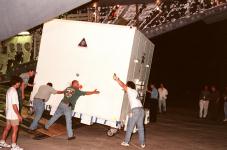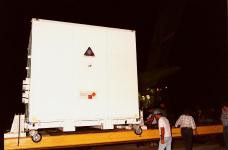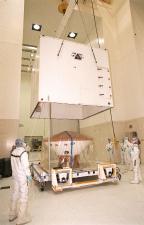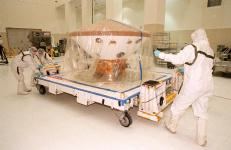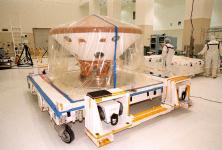
Kennedy Space Center News Release October 1, 1998 KSC Contact: George Diller KSC Release No. 113-98
MARS POLAR LANDER ARRIVES AT KENNEDY SPACE CENTERNASA's Mars Polar Lander arrived at Kennedy Space Center today to begin final preparations for launch. The spacecraft arrived aboard an Air Force C-17 cargo plane which landed at KSC's Shuttle Landing Facility early this morning following its flight from the Lockheed Martin Astronautics plant in Denver, CO. The launch of the Mars Polar Lander is targeted to occur aboard a Boeing Delta II rocket on Jan. 3, 1999. This will be the second spacecraft to be launched in the pair of Mars '98 missions. The Mars Climate Orbiter is planned for launch on Dec. 10, 1998.
The solar-powered spacecraft is designed to touch down on the Martian surface near the northern-most boundary of the south pole. This is near the edge of Mars' thin, carbon dioxide ice sheet which will have receded by the time the lander arrives in December 1999, late spring in the southern hemisphere of Mars. The mission's objective is to study the water cycle at the Martian south pole. The lander also will help scientists learn more about climate change and current resources on Mars, studying such things frosts, dust, water vapor and condensates in the Martian atmosphere.
The Mars Polar Lander is to be readied for launch in NASA's Spacecraft Assembly and Encapsulation Facility-2 (SAEF-2) located in the KSC Industrial Area. Among the activities to be performed will be a functional test of the science instruments and the basic spacecraft subsystems. Checkout of the communications system will be performed, including a verification of the spacecraft's ability to send data to controllers on Earth via the Mars Climate Orbiter and the tracking stations of the Deep Space Network. The spacecraft's radar, used during the final descent, will be installed and the solar arrays will be attached and tested. The Deep Space 2 microprobes will also be installed on the lander's cruise ring. These two probes, developed by NASA's New Millennium Program will test technology and instruments to search for water several feet below the Martian surface. The spacecraft will then be ready for mating with the cruise stage and parachutes used for the trip through the lower Martian atmosphere will then be installed. Next, the spacecraft will be fueled with its attitude control fuel and undergo spin balance testing. Finally, on Dec. 15, the spacecraft will be mated to a Star 48 solid propellant upper stage booster and then prepared for transportation to the launch pad. Meanwhile, at Launch Complex 17, the Delta II rocket will be undergoing erection and prelaunch checkout on Pad B. The first stage is scheduled to be installed into the launcher on Nov. 23. Four solid rocket boosters will be attached around the base of the first stage beginning on Nov. 25. The second stage will be mated atop the first stage on Dec. 2, and the fairing will be hoisted into the clean room of the pad's mobile service tower Dec. 3. The Mars Polar Lander with its upper stage booster will be transported to Complex 17 on Dec. 21 for hoisting atop the Delta and mating to the second stage. After the spacecraft undergoes a state of health check, the spacecraft will be closed out for flight and on Dec. 29 the two halves of the Delta nose fairing placed around it. At liftoff, the spacecraft weighs 1,270 pounds (576 kilograms), is 3.6 feet (106 centimeters) tall, and 12 feet (360 centimeters) long. Launch is planned to occur at the opening of an instantaneous launch window on Jan. 3, 1999 at 3:31 p.m. EST. The nominal launch period is divided into an eight-day primary period (Jan. 3-10) followed by a six-day secondary launch period (Jan. 11-16). The planetary window closes on Jan. 27, 1999. After an 11-month cruise phase, the Mars Polar Lander will arrive at the planet and begin its descent to the surface. An imager onboard the spacecraft will take high resolution photographs during the descent to the surface to establish the geological and physical context of the landing site. A robotic arm will be powered up soon after landing to begin exploring this unknown region with an elaborate, 6.6-foot-long (2-meter) robotic scoop, which will dig shallow trenches to further investigate Mars' climatic history. The lander also will conduct soil analysis experiments on the surface, using a small "chemistry set" and "oven" to determine the thermal properties and evolved gasses in frozen water and dust. Martian surface temperatures, winds, pressure and the amount of dust in the atmosphere will be measured on a daily basis, while a small microphone records the sounds of wind gusts or mechanical operations onboard the spacecraft. The 1998 Mars Climate Orbiter and Mars Polar Lander missions are managed by the Jet Propulsion Laboratory for NASA's Office of Space Science, Washington, D.C. JPL is a division of the California Institute of Technology, Pasadena, CA. Lockheed Martin Astronautics, Denver CO, which built and operates the spacecraft, is JPL's space industry partner in the mission. Launch is the responsibility of NASA's John F. Kennedy Space Center. The Boeing Company is KSC's space industry partner in launch operations. | ||||||
| Home | Mars Polar Lander | Deep Space 2 Microprobes | Mars Climate Orbiter |
| Welcome | Mailing List | Links | Credits |
For questions or comments on this website please refer to our list of contacts.
